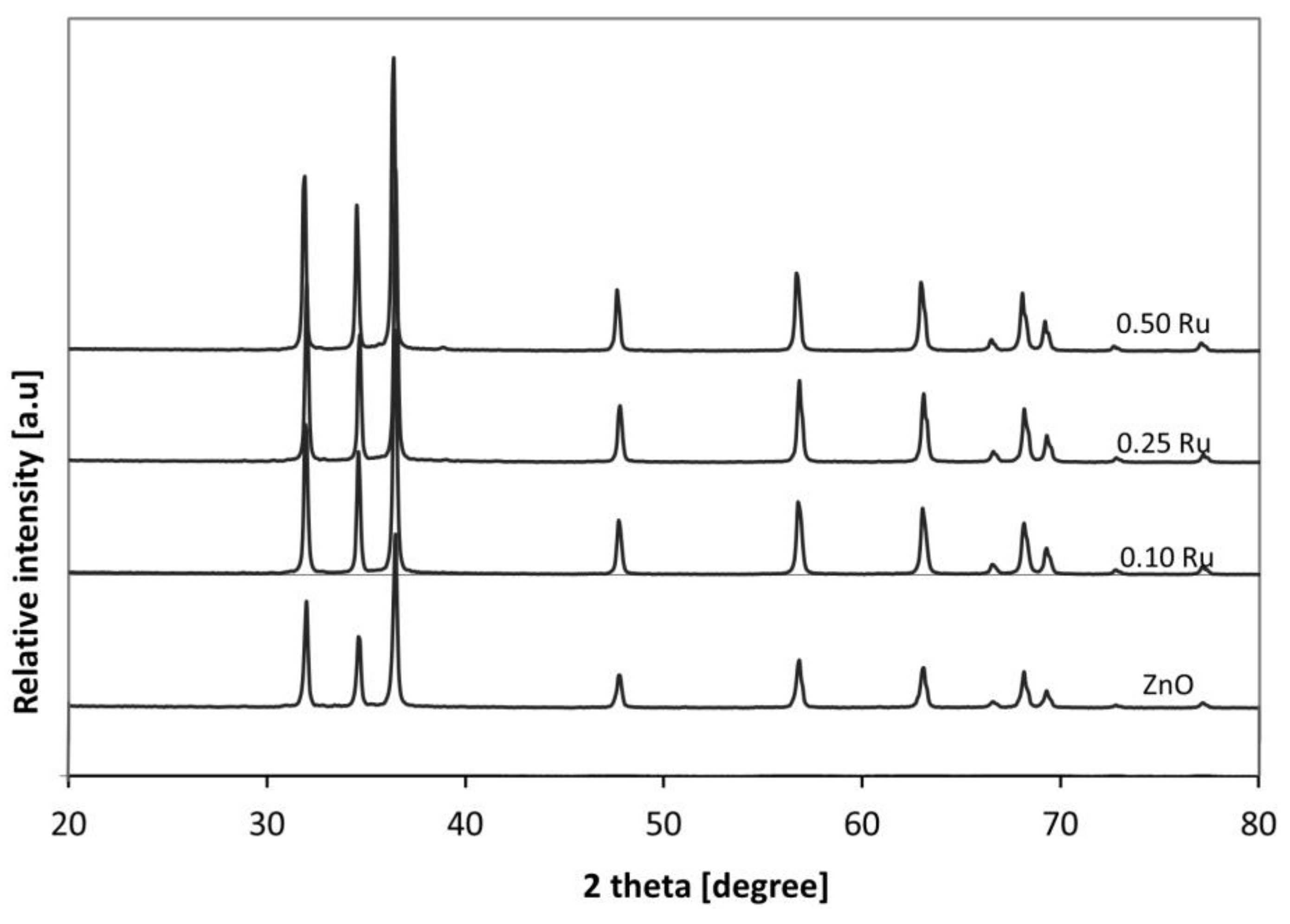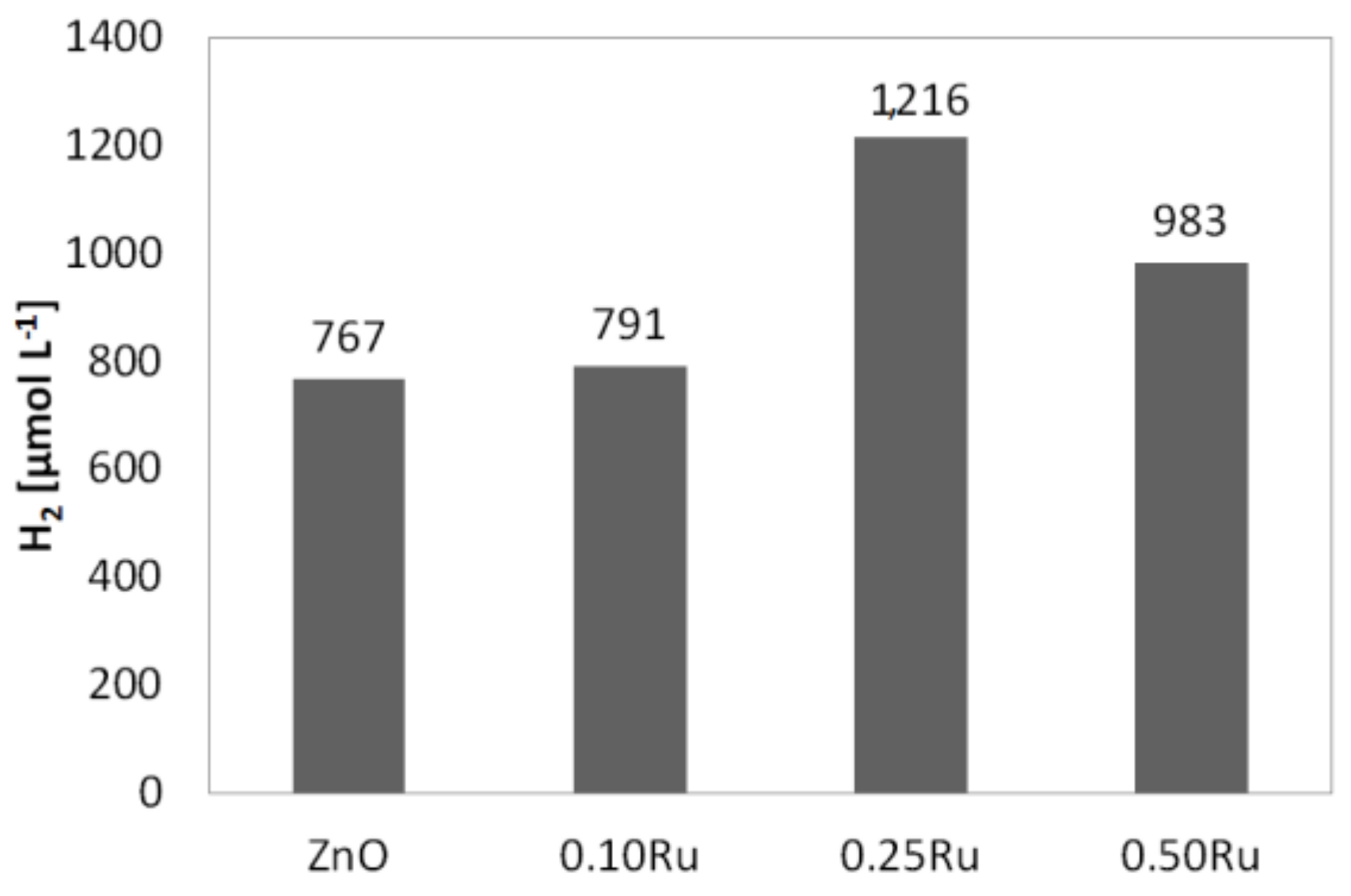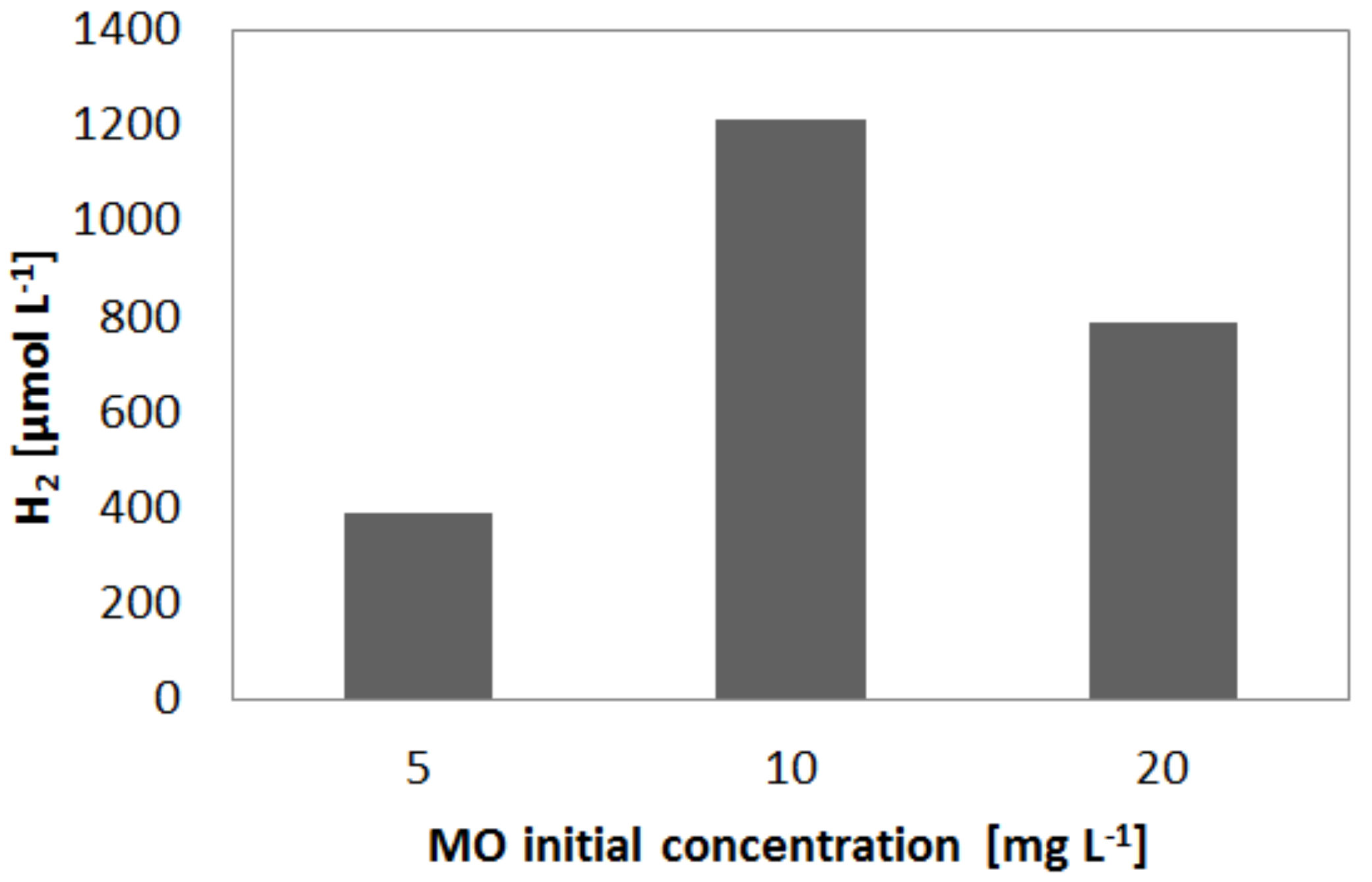Photocatalytic Removal of Methyl Orange Azo Dye with Simultaneous Hydrogen Production Using Ru-Modified ZnO Photocatalyst
Abstract
:1. Introduction
2. Results and Discussion
2.1. Characterizations and Results
2.2. Photocatalytic Activity Results
3. Materials and Methods
3.1. Photocatalysts Preparation and Characterization
3.2. Photocatalytic Experiments
4. Conclusions
Author Contributions
Funding
Acknowledgments
Conflicts of Interest
References
- Liao, C.-H.; Huang, C.-W.; Wu, J. Hydrogen production from semiconductor-based photocatalysis via water splitting. Catalysts 2012, 2, 490–516. [Google Scholar] [CrossRef]
- Iervolino, G.; Vaiano, V.; Sannino, D.; Rizzo, L.; Ciambelli, P. Photocatalytic conversion of glucose to H2 over LaFeO3 perovskite nanoparticles. Chem. Eng. Trans. 2016, 47, 283–288. [Google Scholar]
- Christoforidis, K.C.; Fornasiero, P. Photocatalytic hydrogen production: A rift into the future energy supply. ChemCatChem 2017, 9, 1523–1544. [Google Scholar] [CrossRef]
- Iervolino, G.; Vaiano, V.; Sannino, D.; Rizzo, L.; Palma, V. Enhanced photocatalytic hydrogen production from glucose aqueous matrices on Ru-doped LaFeO3. Appl. Catal. B Environ. 2017, 207, 182–194. [Google Scholar] [CrossRef]
- Patsoura, A.; Kondarides, D.I.; Verykios, X.E. Enhancement of photoinduced hydrogen production from irradiated Pt/TiO2 suspensions with simultaneous degradation of azo-dyes. Appl. Catal. B Environ. 2006, 64, 171–179. [Google Scholar] [CrossRef]
- Kim, J.; Park, Y.; Park, H. Solar hydrogen production coupled with the degradation of a dye pollutant using TiO2 modified with platinum and nafion. Int. J. Photoenergy 2014, 2014, 324859. [Google Scholar] [CrossRef]
- Gupta, V. Application of low-cost adsorbents for dye removal—A review. J. Environ. Manag. 2009, 90, 2313–2342. [Google Scholar] [CrossRef]
- Crini, G. Non-conventional low-cost adsorbents for dye removal: A review. Bioresour. Technol. 2006, 97, 1061–1085. [Google Scholar] [CrossRef]
- Vaiano, V.; Iervolino, G. Facile method to immobilize ZnO particles on glass spheres for the photocatalytic treatment of tannery wastewater. J. Colloid Interface Sci. 2018, 518, 192–199. [Google Scholar] [CrossRef]
- Somasundaram, S.; Veerakumar, P.; Lin, K.C.; Kumaravel, V. Application of nanocomposites for photocatalytic removal of dye contaminants. Photocatal. Funct. Mater. Environ. Remediat. 2019, 131–161. [Google Scholar] [CrossRef]
- Bouras, H.D.; Isik, Z.; Arikan, E.B.; Bouras, N.; Chergui, A.; Yatmaz, H.C.; Dizge, N. Photocatalytic oxidation of azo dye solutions by impregnation of ZnO on fungi. Biochem. Eng. J. 2019, 146, 150–159. [Google Scholar] [CrossRef]
- Zuorro, A.; Lavecchia, R.; Monaco, M.M.; Iervolino, G.; Vaiano, V. Photocatalytic degradation of azo dye reactive violet 5 on Fe-doped titania catalysts under visible light irradiation. Catalysts 2019, 9, 645. [Google Scholar] [CrossRef]
- Kim, J.; Monllor-Satoca, D.; Choi, W. Simultaneous production of hydrogen with the degradation of organic pollutants using TiO2 photocatalyst modified with dual surface components. Energy Environ. Sci. 2012, 5, 7647–7656. [Google Scholar] [CrossRef]
- He, Y.; Sutton, N.B.; Rijnaarts, H.H.; Langenhoff, A.A. Degradation of pharmaceuticals in wastewater using immobilized TiO2 photocatalysis under simulated solar irradiation. Appl. Catal. B Environ. 2016, 182, 132–141. [Google Scholar] [CrossRef]
- Bahruji, H.; Bowker, M.; Davies, P.R.; Pedrono, F. New insights into the mechanism of photocatalytic reforming on Pd/TiO2. Appl. Catal. B Environ. 2011, 107, 205–209. [Google Scholar] [CrossRef]
- Chu, K.H.; Ye, L.; Wang, W.; Wu, D.; Chan, D.K.L.; Zeng, C.; Yip, H.Y.; Jimmy, C.Y.; Wong, P.K. Enhanced photocatalytic hydrogen production from aqueous sulfide/sulfite solution by ZnO0.6S0.4 with simultaneous dye degradation under visible-light irradiation. Chemosphere 2017, 183, 219–228. [Google Scholar] [CrossRef]
- Wang, J.; Zhang, P.; Li, X.; Zhu, J.; Li, H. Synchronical pollutant degradation and H2 production on a Ti3+-doped TiO2 visible photocatalyst with dominant (0 0 1) facets. Appl. Catal. B Environ. 2013, 134, 198–204. [Google Scholar] [CrossRef]
- Romão, J.; Salata, R.; Park, S.-Y.; Mul, G. Photocatalytic methanol assisted production of hydrogen with simultaneous degradation of methyl orange. Appl. Catal. A Gen. 2016, 518, 206–212. [Google Scholar] [CrossRef]
- Badawy, M.I.; Ali, M.E.; Ghaly, M.Y.; El-Missiry, M.A. Mesoporous simonkolleite—TiO2 nanostructured composite for simultaneous photocatalytic hydrogen production and dye decontamination. Process Saf. Environ. Prot. 2015, 94, 11–17. [Google Scholar] [CrossRef]
- Vaiano, V.; Jaramillo-Paez, C.A.; Matarangolo, M.; Navío, J.A.; del Carmen Hidalgo, M. UV and visible-light driven photocatalytic removal of caffeine using ZnO modified with different noble metals (Pt, Ag and Au). Mater. Res. Bull. 2019, 112, 251–260. [Google Scholar] [CrossRef]
- Tijare, S.N.; Joshi, M.V.; Padole, P.S.; Mangrulkar, P.A.; Rayalu, S.S.; Labhsetwar, N.K. Photocatalytic hydrogen generation through water splitting on nano-crystalline LaFeO3 perovskite. Int. J. Hydrogen Energy 2012, 37, 10451–10456. [Google Scholar] [CrossRef]
- Xie, M.-Y.; Su, K.-Y.; Peng, X.-Y.; Wu, R.-J.; Chavali, M.; Chang, W.-C. Hydrogen production by photocatalytic water-splitting on Pt-doped TiO2–ZnO under visible light. J. Taiwan Inst. Chem. Eng. 2017, 70, 161–167. [Google Scholar] [CrossRef]
- Chen, X.; Lou, Y.; Dayal, S.; Qiu, X.; Krolicki, R.; Burda, C.; Zhao, C.; Becker, J. Doped semiconductor nanomaterials. J. Nanosci. Nanotechnol. 2005, 5, 1408–1420. [Google Scholar] [CrossRef] [PubMed]
- Ibhadon, A.; Greenway, G.; Yue, Y. Photocatalytic activity of surface modified TiO2/RuO2/SiO2 nanoparticles for azo-dye degradation. Catal. Commun. 2008, 9, 153–157. [Google Scholar] [CrossRef]
- Aranganayagam, K.; Senthilkumaar, S.; Ganapathi Subramaniam, N.; Kang, T.W. Ruthenium doped ZnO semiconductor: Synthesis, characterization and photodegradation of azo dye. Int. J. Nanosci. 2013, 12, 1350009. [Google Scholar] [CrossRef]
- Yayapao, O.; Thongtem, T.; Phuruangrat, A.; Thongtem, S. Synthesis and characterization of highly efficient Gd doped ZnO photocatalyst irradiated with ultraviolet and visible radiations. Mater. Sci. Semicond. Process. 2015, 39, 786–792. [Google Scholar] [CrossRef]
- Manríquez, M.E.; Noreña, L.E.; Wang, J.A.; Chen, L.; Salmones, J.; González-García, J.; Reza, C.; Tzompantzi, F.; Hernández Cortez, J.G.; Ye, L. One-pot synthesis of Ru-doped ZnO oxides for photodegradation of 4-chlorophenol. Int. J. Photoenergy 2018, 2018, 7605306. [Google Scholar] [CrossRef]
- Reksten, A.H.; Russell, A.E.; Richardson, P.W.; Thompson, S.J.; Mathisen, K.; Seland, F.; Sunde, S. Strategies for the analysis of the elemental metal fraction of Ir and Ru oxides via XRD, XANES, and EXAFS. Phys. Chem. Chem. Phys. 2019, 21, 12217–12230. [Google Scholar] [CrossRef]
- Wojnarowicz, J.; Mukhovskyi, R.; Pietrzykowska, E.; Kusnieruk, S.; Mizeracki, J.; Lojkowski, W. Microwave solvothermal synthesis and characterization of manganese-doped ZnO nanoparticles. Beilstein J. Nanotechnol. 2016, 7, 721–732. [Google Scholar] [CrossRef]
- Zhang, Q.; Liu, J.-K.; Wang, J.-D.; Luo, H.-X.; Lu, Y.; Yang, X.-H. Atmospheric self-induction synthesis and enhanced visible light photocatalytic performance of Fe3+ doped Ag-ZnO mesocrystals. Ind. Eng. Chem. Res. 2014, 53, 13236–13246. [Google Scholar] [CrossRef]
- Janotti, A.; Van de Walle, C.G. Fundamentals of zinc oxide as a semiconductor. Rep. Progress Phys. 2009, 72, 126501. [Google Scholar] [CrossRef]
- Ilanchezhiyan, P.; Kumar, G.M.; Subramanian, M.; Jayavel, R. Effect of Pr doping on the structural and optical properties of ZnO nanorods. Mater. Sci. Eng. B 2010, 175, 238–242. [Google Scholar] [CrossRef]
- Bloh, J.Z.; Dillert, R.; Bahnemann, D.W. Ruthenium-modified zinc oxide, a highly active vis-photocatalyst: The nature and reactivity of photoactive centres. Phys. Chem. Chem. Phys. 2014, 16, 5833–5845. [Google Scholar] [CrossRef] [PubMed] [Green Version]
- Sakthivel, S.; Shankar, M.; Palanichamy, M.; Arabindoo, B.; Bahnemann, D.; Murugesan, V. Enhancement of photocatalytic activity by metal deposition: Characterisation and photonic efficiency of Pt, Au and Pd deposited on TiO2 catalyst. Water Res. 2004, 38, 3001–3008. [Google Scholar] [CrossRef] [PubMed]
- Chakrabarti, S.; Dutta, B.K. Photocatalytic degradation of model textile dyes in wastewater using ZnO as semiconductor catalyst. J. Hazard. Mater. 2004, 112, 269–278. [Google Scholar] [CrossRef]
- Mohagheghian, A.; Karimi, S.-A.; Yang, J.-K.; Shirzad-Siboni, M. Photocatalytic degradation of a textile dye by illuminated tungsten oxide nanopowder. J. Adv. Oxid. Technol. 2015, 18, 61–68. [Google Scholar] [CrossRef]







| Photocatalyst (Co-Catalyst) | Sacrificing Agent | Light Source * | H2 Production Rate (µmol g−1 h−1) | Reference |
|---|---|---|---|---|
| ZnO0.6S0.4 | Sulfide/sulfite + RV5 | Vis | 49.2 | [16] |
| Ti3+-doped TiO2 (1% Pt) | Methylene Blue | Vis | ~14 | [17] |
| Ti3+-doped TiO2 (1% Pt) | Rhodamine B | Vis | ~8.3 | [17] |
| Ti3+-doped TiO2 (1% Pt) | Methyl Orange | Vis | ~5 | [17] |
| TiO2 (0.5% Pt) | Methanol + Methyl Orange | UV–vis | ~420 | [18] |
| Simonkolleite–TiO2 | Remazole Red | UV–vis | ~825 | [19] |
| TiO2 (0.5% Pt) | Acid Orange 7 | UV–vis | ~450 | [5] |
| Pt/TiO2/Nf | RhB dye pollutant + EDTA | UV | ~380 | [6] |
| Photocatalyst | Ru Nominal Amount [%mol] | Ru Measured * Amount [%mol] | Band Gap Energy ** [eV] | Crystallite Size [nm] | SSA ** [m2/g] |
|---|---|---|---|---|---|
| ZnO | 0 | 0 | 3.20 | 35 | 5.5 |
| 0.10Ru | 0.10 | 0.09 | 3.20 | 34 | 6.1 |
| 0.25Ru | 0.25 | 0.22 | 3.20 | 32 | 7.2 |
| 0.50Ru | 0.5 | 0.53 | 3.17 | 33 | 5.8 |
© 2019 by the authors. Licensee MDPI, Basel, Switzerland. This article is an open access article distributed under the terms and conditions of the Creative Commons Attribution (CC BY) license (http://creativecommons.org/licenses/by/4.0/).
Share and Cite
Vaiano, V.; Iervolino, G. Photocatalytic Removal of Methyl Orange Azo Dye with Simultaneous Hydrogen Production Using Ru-Modified ZnO Photocatalyst. Catalysts 2019, 9, 964. https://doi.org/10.3390/catal9110964
Vaiano V, Iervolino G. Photocatalytic Removal of Methyl Orange Azo Dye with Simultaneous Hydrogen Production Using Ru-Modified ZnO Photocatalyst. Catalysts. 2019; 9(11):964. https://doi.org/10.3390/catal9110964
Chicago/Turabian StyleVaiano, Vincenzo, and Giuseppina Iervolino. 2019. "Photocatalytic Removal of Methyl Orange Azo Dye with Simultaneous Hydrogen Production Using Ru-Modified ZnO Photocatalyst" Catalysts 9, no. 11: 964. https://doi.org/10.3390/catal9110964
APA StyleVaiano, V., & Iervolino, G. (2019). Photocatalytic Removal of Methyl Orange Azo Dye with Simultaneous Hydrogen Production Using Ru-Modified ZnO Photocatalyst. Catalysts, 9(11), 964. https://doi.org/10.3390/catal9110964






